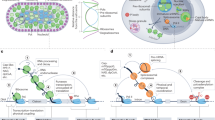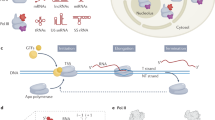Abstract
The essential yeast proteins Yra1 and Sub2 are messenger RNA export factors that have conserved counterparts in metazoans, designated Aly and UAP56, respectively1,2,3,4,5,6,7. These factors couple the machineries that function in splicing and export of mRNA1,2,3,4,5,6,7. Here we show that both Yra1 and Sub2 are stoichiometrically associated with the heterotetrameric THO complex8, which functions in transcription in yeast8,9,10,11. We also show that Sub2 and Yra1 interact genetically with all four components of the THO complex (Tho2, Hpr1, Mft1 and Thp2). Moreover, these components operate in the export of bulk poly(A)+ RNA as well as of mRNA derived from intronless genes. Both Aly and UAP56 associate with human counterparts of the THO complex. Together, these data define a conserved complex, designated the TREX (‘transcription/export’) complex. The TREX complex is specifically recruited to activated genes during transcription and travels the entire length of the gene with RNA polymerase II. Our data indicate that the TREX complex has a conserved role in coupling transcription to mRNA export.
This is a preview of subscription content, access via your institution
Access options
Subscribe to this journal
Receive 51 print issues and online access
$199.00 per year
only $3.90 per issue
Buy this article
- Purchase on Springer Link
- Instant access to full article PDF
Prices may be subject to local taxes which are calculated during checkout




Similar content being viewed by others
References
Sträßer, K. & Hurt, E. C. Yra1p, a conserved nuclear RNA binding protein, interacts directly with Mex67p and is required for mRNA export. EMBO J. 19, 410–420 (2000)
Stutz, F. et al. REF, an evolutionarily conserved family of hnRNP-like proteins, interacts with TAP/Mex67p and participates in mRNA nuclear export. RNA 6, 638–650 (2000)
Zhou, Z. L. et al. The protein Aly links pre-messenger-RNA splicing to nuclear export in metazoans. Nature 407, 401–405 (2000)
Gatfield, D. et al. The DExH/D box protein HEL/UAP56 is essential for mRNA nuclear export in Drosophila. Curr. Biol. 11, 1716–1721 (2001)
Jensen, T. H., Boulay, J., Rosbash, M. & Libri, D. The DECD box putative ATPase Sub2p is an early mRNA export factor. Curr. Biol. 11, 1711–1715 (2001)
Luo, M.-J. et al. Pre-mRNA splicing and mRNA export linked by direct interactions between UAP56 and Aly. Nature 413, 644–647 (2001)
Sträßer, K. & Hurt, E. C. Splicing factor Sub2p is required for nuclear export through its interaction with Yra1p. Nature 413, 648–652 (2001)
Chávez, S. et al. A protein complex containing Tho2, Hpr1, Mft1 and a novel protein, Thp2, connects transcription elongation with mitotic recombination in Saccharomyces cerevisiae. EMBO J. 19, 5824–5834 (2000)
Chavez, S. & Aguilera, A. The yeast HPR1 gene has a functional role in transcriptional elongation that uncovers a novel source of genome instability. Genes Dev. 11, 3459–3470 (1997)
Piruat, J. I. & Aguilera, A. A novel yeast gene, THO2, is involved in RNA pol II transcription and provides new evidence for transcriptional elongation-associated recombination. EMBO J. 17, 4859–4872 (1998)
West, R. W., Kruger, B., Thomas, S., Ma, J. & Milgrom, E. RLR1 (THO2), required for expressing lacZ fusions in yeast, is conserved from yeast to humans and is a suppressor of SIN4. Gene 243, 195–205 (2000)
Rigaut, G. et al. A generic protein purification method for protein complex characterization and proteome exploration. Nature Biotechnol. 17, 1030–1032 (1999)
Chang, M. et al. A complex containing RNA polymerase II, Paf1p, Cdc73p, Hpr1p, and Ccr4p plays a role in protein kinase C signalling. Mol. Cell. Biol. 19, 1056–1067 (1999)
Fan, H. Y., Merker, R. J. & Klein, H. L. High-copy-number expression of Sub2p, a member of the RNA helicase superfamily, suppresses hpr1-mediated genomic instability. Mol. Cell. Biol. 21, 5459–5470 (2001)
Kulish, D. & Struhl, K. TFIIS enhances transcriptional elongation through an artificial arrest site in vivo. Mol. Cell. Biol. 21, 4162–4168 (2001)
Piruat, J. I., Chavez, S. & Aguilera, A. The yeast HRS1 gene is involved in positive and negative regulation of transcription and shows genetic characteristics similar to SIN4 and GAL11. Genetics 147, 1585–1594 (1997)
Reed, R. & Hurt, E. C. A conserved mRNA export machinery coupled to pre-mRNA splicing. Cell 108, 523–531 (2002)
Schneiter, R. et al. The Saccharomyces cerevisiae hyperrecombination mutant hpr1Δ is synthetically lethal with two conditional alleles of the acetyl coenzyme A carboxylase gene and causes a defect in nuclear export of polyadenylated RNA. Mol. Cell. Biol. 19, 3415–3422 (1999)
Fleckner, J., Zhang, M., Valcarcel, J. & Green, M. R. U2AF65 recruits a novel human DEAD box protein required for the U2 snRNP–branchpoint interaction. Genes Dev. 11, 1864–1872 (1997)
Kistler, A. L. & Guthrie, C. Deletion of MUD2, the yeast homolog of U2AF65, can bypass the requirement for Sub2, an essential spliceosomal ATPase. Genes Dev. 15, 42–49 (2001)
Libri, D., Graziani, N., Saguez, C. & Boulay, J. Multiple roles for the yeast SUB2/yUAP56 gene in splicing. Genes Dev. 15, 36–41 (2001)
Zhang, M. & Green, M. R. Identification and characterization of yUAP/Sub2p, a yeast homolog of the essential human pre-mRNA splicing factor hUAP56. Genes Dev. 15, 30–35 (2001)
Lei, E. P., Krebber, H. & Silver, P. A. Messenger RNAs are recruited for nuclear export during transcription. Genes Dev. 15, 1771–1782 (2001)
Baßler, J. et al. Identification of a 60S pre-ribosomal particle that is closely linked to nuclear export. Mol. Cell 8, 517–529 (2001)
Kuras, L. & Struhl, K. Binding of TBP to promoters in vivo is stimulated by activators and requires Pol II holoenzyme. Nature 399, 609–613 (1999)
Acknowledgements
We are grateful to J. Lechner for assistance in the mass spectrometry, J. Bassler for initial help in this project and G. B. Winkler and J. Q. Svejstrup for their help in the isolation of the His-tagged THO complex. E.H. was supported by grants from the Deutsche Forschungsgemeinschaft (SFB, Gottfried Wilhelm Leibniz-Program) and Fonds der Chemischen Industrie; A.A. by grants from the Spanish Ministry of Science and Technology and the Human Frontier Science Program; R.R. and K.S. by National Institutes of Health (NIH) grants. S.M. is supported by the fellowship programme for Japanese scholars and researchers and P.M. is supported by an NIH postdoctoral fellowship.
Author information
Authors and Affiliations
Corresponding authors
Ethics declarations
Competing interests
The authors declare that they have no competing financial interests
Rights and permissions
About this article
Cite this article
Sträßer, K., Masuda, S., Mason, P. et al. TREX is a conserved complex coupling transcription with messenger RNA export. Nature 417, 304–308 (2002). https://doi.org/10.1038/nature746
Received:
Accepted:
Published:
Issue Date:
DOI: https://doi.org/10.1038/nature746
This article is cited by
-
Structural differences between the closely related RNA helicases, UAP56 and URH49, fashion distinct functional apo-complexes
Nature Communications (2024)
-
CRISPR-dCas13-tracing reveals transcriptional memory and limited mRNA export in developing zebrafish embryos
Genome Biology (2023)
-
The master energy homeostasis regulator PGC-1α exhibits an mRNA nuclear export function
Nature Communications (2023)
-
THOC3 interacts with YBX1 to promote lung squamous cell carcinoma progression through PFKFB4 mRNA modification
Cell Death & Disease (2023)
-
Temporal-iCLIP captures co-transcriptional RNA-protein interactions
Nature Communications (2023)
Comments
By submitting a comment you agree to abide by our Terms and Community Guidelines. If you find something abusive or that does not comply with our terms or guidelines please flag it as inappropriate.



